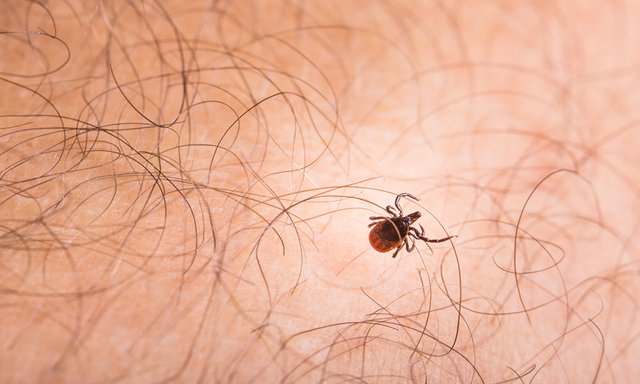
We know that ticks are responsible for Lyme disease. They are carriers of dangerous bacteria called Lyme disease spirochetes. The disease is called Lyme borreliosis disease.
Lyme disease bacteria feed by burning sugar. This process occurs in anaerobic transformation. Any oxygenation of the body helps in the fight against this bacterium. They are very smart, they can change their character. Sometimes, they shed the sheath in the form of a cell wall, thanks to that antibiotics are not effective in fighting them, other times they can hide even inside our cells, ex. tooth pulp.
Remember that from a moment of the tick bite (infected by this bacterium) to human infection it takes about 24 hours. So let’s remember that after every trip to the forest, park, meadow, playing on the grass, carefully check your skin and clothing if you don’t have a tick. This also applies to the skin of your dogs or cats, from which the tick can get on your skin.
Lyme disease is a multi-organ disease, it can affect many places, organs of your body. The severity of the disease can vary from person to person. It can include both the skin, heart, joint, muscular and nervous systems.
About 30 percent of ticks are infected with Lyme disease spirochetes. Incorrectly treated Lyme disease can lead to disability or even death.
Therefore, in the fight against it, you should use several therapies at once.
It’s best to use simultaneously:
treatment with strong herbs,
support with probiotics,
administration of vitamins,
appropriately adapted sugar-free diet (e.g. ketogenic),
a lot of rest.
Antibiotic treatment alone is rarely effective
When you find a tick, it’s best to remove it with a pair of tweezers and disinfect the place. If you are afraid to remove the tick yourself, you should quickly see a doctor. Such a tick can be tested for Lyme disease. Regardless of the bite site, you must observe this place for the next 2-3 weeks to see if there is any characteristic erythema associated with this disease. In case of uncertainty, you can consult a doctor who knows and treats this disease.
Here are examples of the symptoms associated with Lyme disease:
migratory erythema, which is characterized by redness of the skin, it edges towards the periphery and disappears in the middle,
lymphocytic skin lymphoma is extremely rare and appears several weeks after being bitten by a tick like a sino-red, single, painless lump. It is located mainly on the auricles, scrotum and nipples,
chronic atrophic dermatitis of the limbs. These are usually reddish-blue, asymmetrical skin changes that appear several years after infection with the bacterium, initially occurring as inflammatory edema, and then dominate,
arthritis manifested in the early stages of migrating pain in the bones, joints, muscles, tendons. Later, however, recurrent arthritis occurs, in which pains are accompanied by swelling, which is particularly severe when moving. Most often it concerns knee, shoulder, baroque, elbow, wrist, hip and ankle joints. Less often this applies to small joints, ex. hands or feet,
myocarditis, heart arrhythmias most commonly occur.
Diseases that arise after infection with Lyme disease and affect the nervous system neuroborreliosis are:
lymphocytic meningitis, usually the course is mild, the only symptom of this disease can be a headache,
cranial neuritis, nerve palsy [facial palsy], could be bilateral,
inflammation of the nerve roots and peripheral nerves, which is manifested by severe neuralgia, this pain intensifies at night.
Other:
Post Treatment Lyme Disease Syndrome is several symptoms that persist despite proper treatment. These include apathy, fatigue, headaches, musculoskeletal pain, paresthesia, problems with memory and concentration.
The most important is the proper diagnostics. It is very difficult.
A blood test is not sufficient to properly diagnose the disease. Even a positive serological result without clinical symptoms typical of Lyme disease does not authorize diagnosis.
You should always carry out a detailed medical examination; list the symptoms as well as those that accompanied you in the past, do laboratory tests to make the correct diagnosis.
With properly treated Lyme disease, the prognosis is good, but the treatment is long. There are many protocols and treatments for Lyme disease worldwide with varying degrees of effectiveness.
Here are the mixtures of medicinal plants used to treat Lyme disease by dr.med. Janusz Wietecha:
Garlic extract, it is a very valuable plant with antibacterial activity, including in the fight against Borrelia spirochete. It also has anti-fungal and antiatherosclerotic effects, reducing hypertension. A condensed extract [minimum DER 10: 1] hydroalcoholic is used,
Wild Teasel Extract concentrated 10: 1, water-ethanol extract. It is effective in long, difficult infections, used to treat Lyme disease.
Hoary Rock-Rose Extract, 10: 1, water-ethanol, also used to treat infections. It strengthens the immune system, contains a lot of polyphenols, which are strong antioxidants.
Cat’s Claw Bark Extract, 10: 1, water-ethanol, contains alkaloids that stimulate white blood cells that destroy bacteria, have anti-inflammatory, antioxidant, and antiviral properties.
Japanese knotweed Root Extract,10: 1, water-ethanol, antibacterial for Lyme disease spirochetes, stimulates the immune system. It contains resveratrol, which stimulates microcirculation, regulates metabolism. It contains a lot of selenium, copper, manganese, iron, and zinc.
Creat Leaves Extract, strongly concentrated 10:1, water-ethanol. It belongs to the unique herbs with antibacterial properties in the fight against Lyme disease. It strengthens immunity, speeds up digestion and cleanses our body of toxins.
Read more at healthyasabirch.com